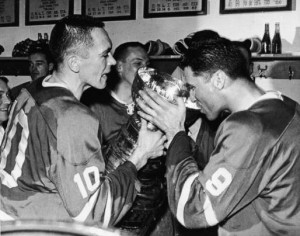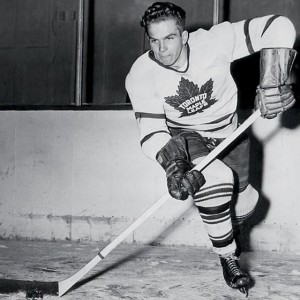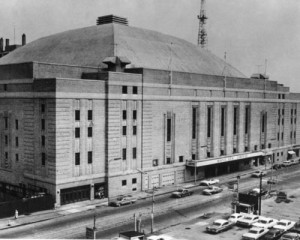The Toronto Maple Leafs are one of the most storied and iconic franchises in the entire National Hockey League. They have a century of history that spans all the way back to the early 1900s. When you have an organization as venerable as the Maple Leafs, chances are there have been a multitude of important moments and players to recognize.
In the book, 100 Years in Blue and White: A Century of Hockey in Toronto, some of the most incredible moments in Maple Leafs history are documented through the eyes of Toronto Star columnists. Some of the writers who contributed articles are legendary names within the Canadian journalism scene including the likes of Lou Marsh, Red Burnett, Milt Dunnell and Jim Proudfoot.

They captured all the highs and lows and historic moments such as the Toronto Arenas winning the franchise’s first Stanley Cup back in 1917-18 or George Armstrong captaining the 1967 squad to the club’s last Cup win.
It also details more recent periods in Leafs’ history, such as the era of Mats Sundin, the infamous 2013 Game 7 playoff collapse and the future superstars, like Mitch Marner and Auston Matthews, who are currently finding their way in the modern day NHL.
I recently had the pleasure of interviewing Damien Cox, a columnist for the Toronto Star and a regular on Sportsnet radio and television broadcasts. Cox has been covering the NHL and the Toronto Maple Leafs as a reporter and columnist for over 22 years and he was able to give me some terrific insight into the book.
For Cox, the appeal to help with the book was simple. He said, “It’s a really cool book to be a part of. You’re part of the history. And for me, it is a dual history. It’s a history of the Toronto Maple Leafs and it’s also the history of the Toronto Star. I’m a part of both. For a kid who grew up in Hamilton, I never imagined any of this.”
Writing Styles Past and Present
“It turned out like an auction room watch – looks well but it won’t withstand the wear and tear.” “The ragged looking battlers in the green shirts hopped right into the silverware scramble.” “It was as welcome as whiskey at an Irish wake.” All of the previous phrases were used in articles dating from 1918 to 1932. Could that type of colourful and flowery writing make a comeback in 2016-17?
According to Cox, “The style of sports writing back then was so different. The style of journalism was as well. It’s a very flowery type of writing. I have a real affection for that because you can really see the evolution of writing. Back then, they weren’t as analytical or as critical. They were more a part of the home team, of Toronto trying to win something. I don’t know where those guys learned. Many started off as copy boys and just became writers. They just learned how to write a certain way that people liked.”
Why are the Leafs so Iconic?

I asked Cox to imagine that I knew nothing about the Maple Leafs. If that were the case, what articles from the book would he recommend that I read to get the gist of the history?
He responded, “the first was written by Red Burnett about Bill Barilko and the 1951 Stanley Cup victory. For me, to be able to sit there and read the story that was printed in the Star that day is pretty unique. I think it shows a connection between the Leafs and hockey legends. Barilko became a legend. They wrote songs about him.”
The song, “Fifty Mission Cap” by legendary Canadian band The Tragically Hip, is the most famous song about Barilko, his goal, and subsequent disappearance.
Cox goes on to say, “Another is written by Frank Orr in 1978 that talks about the Leafs beating the Islanders after Lanny McDonald’s goal. That was a time that looked as though the Leafs had really gotten it together. They had a good team with McDonald, Sittler, Palmateer in net, Tiger Williams, Ian Turnbull and, on defense, Borje Salming.”

“These were outstanding players. I think that’s the article that tips you up more towards the modern era. It’s the post-1967 era. Good things happened, but not enough good things. Every time it looked as though they were ready to take off and challenge for the Cup, something would take them in another direction.”
“I think into the modern era, I was there that night (referring to the Game 7 collapse and loss at the hands of the Bruins) in Boston and that was a crushing night. That’s sort of the frustration of the past decade.”
What Cox is referencing here is the Leafs finally making the postseason after years of frustration. They take on their Boston rivals and push them all the way to seven games. It’s do-or-die and the Leafs are looking like they are going to pull off the upset. However, they end up losing in the most devastating way possible.

According to Cox, “it all depends on when you entered the conversation.” It’s different for each and every person. Some remember the Leafs’ Cup-winning glory days.
Others, such as myself, have fond memories of the Mats Sundin era as well as the several years of frustration and playoff misses that ensued. This year will bring new followers who will be attracted by the likes of Marner, Matthews and Nylander as their first point of contact and subsequent hope for the future.
Wrapping Up
This book is a great holiday gift for any Leafs fan or just a fan of hockey history in general. There are also some incredible pictures that serve to highlight the biggest moments in Leafs history.

Cox mentioned that the picture that stood out to him the most was the image of Lanny McDonald leaving a Leafs practice on Dec. 28, 1979. Minutes later, he found out he was traded to the Colorado Rockies. It was a highly controversial move that stirred up animosity among the remaining Leaf players, who could not understand why such a popular teammate was dealt.
My favourite image comes later in the book. It shows the entire Leafs team lining up along the blue line for their final game at Maple Leaf Gardens, which took place on Feb. 14, 1999. The date symbolizes the end of an era that many will look back on with fond memories. A picture is worth a thousand words, and while that phrase may be a cliche, there are many historic images in the book that do that statement great justice.
My dad, a lifelong fan, would always tell me stories of the players he remembers watching throughout the years. He filled my head with the exploits of Borje Salming, Darryl Sittler and Wendel Clark, among others.
Through this book and the columns published within it, I have been given a window into the past that really helps me appreciate just how much history the Maple Leafs organization has.
The book allows various generations of Leafs fans or hockey fans in general, to gain an in-depth understanding of the evolution of the Toronto Maple Leafs over the last 100 years. It’s a bond the various generations will be able to share going forward. This book is most definitely an essential read for any follower of the Blue and White.
You can get your own copy of 100 Years in Blue and White: A Century of Hockey in Toronto from Amazon. Do yourself a favour and get it today.